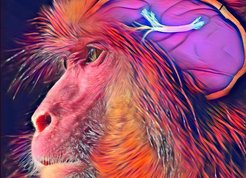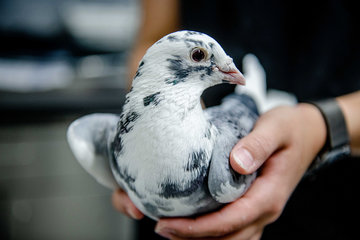The roots of language
Early evolutionary origin of the human language pathway discovered
A brain imaging study of humans, apes and monkeys by scientists from Newcastle University and Max Planck Institute for Human Cognitive and Brain Sciences published in Nature Neuroscience reports the discovery of an earlier evolutionary origin to the human language pathway and sheds new light on its remarkable transformation.

The human language pathway has an evolutionary basis in the auditory system of nonhuman primates.
The discovery is analogous to finding a fossil that illuminates evolutionary history. However, unlike bones, brains did not fossilize. Thus, neuroscientists infer what the brains of common ancestors may have been like by studying brain scans of living primates and comparing them to humans. The study relied on the analysis of auditory regions and brain pathways in monkeys, apes and humans.
Chris Petkov at Newcastle University Medical School, the study lead notes, “We predicted that the human language pathway may have had an evolutionary basis in the auditory system of nonhuman primates. I admit we were astounded to see evidence for evolutionary homologs of the human language pathway in both apes and monkeys, linked by way of an auditory origin. The precursor pathway was hiding in plain sight within the auditory system of nonhuman primates!”
This pathway in the human brain processes speech sounds and interconnects auditory cortex with frontal lobe regions important for language. Although only humans have speech and language, the link via the auditory pathway in other primates suggests an evolutionary basis in auditory cognition and vocal communication.
The discovery pushes back the evolutionary origin of the human language pathway by at least 20 million years. Previously, a precursor pathway was thought by many scientists to have emerged more recently, about 5 million years ago, with a common ancestor to apes and humans.
The study also illuminates the remarkable transformation of the human language pathway. A key human unique difference was indicated: the human left side of this brain pathway was stronger and the right side appears to have diverged from the auditory evolutionary prototype to involve non-auditory parts of the brain.
The study relied on brain scans from openly shared resources by the global scientific community and it generated original new brain scans that will be shared internationally to inspire further discovery. The authors predict that the auditory precursor to the human language pathway may be even older, inspiring neurobiological search for its earliest evolutionary origins in animals more distantly related to humans.
Timothy Griffiths, consultant neurologist at Newcastle University Medical School and joint senior author on the study notes, “This discovery has tremendous potential for understanding which aspects of human auditory cognition and language can be studied with animal models in ways not possible with humans and apes. The study has already inspired research underway with neurology patients.”
Institutions that contributed to this study:
Newcastle University Medical School, United Kingdom
Max Planck Institute for Human Cognitive and Brain Sciences, Germany
Birkbeck UCL Centre for NeuroImaging, United Kingdom
University of Texas MD Anderson Cancer Center, USA
University of Iowa, USA












